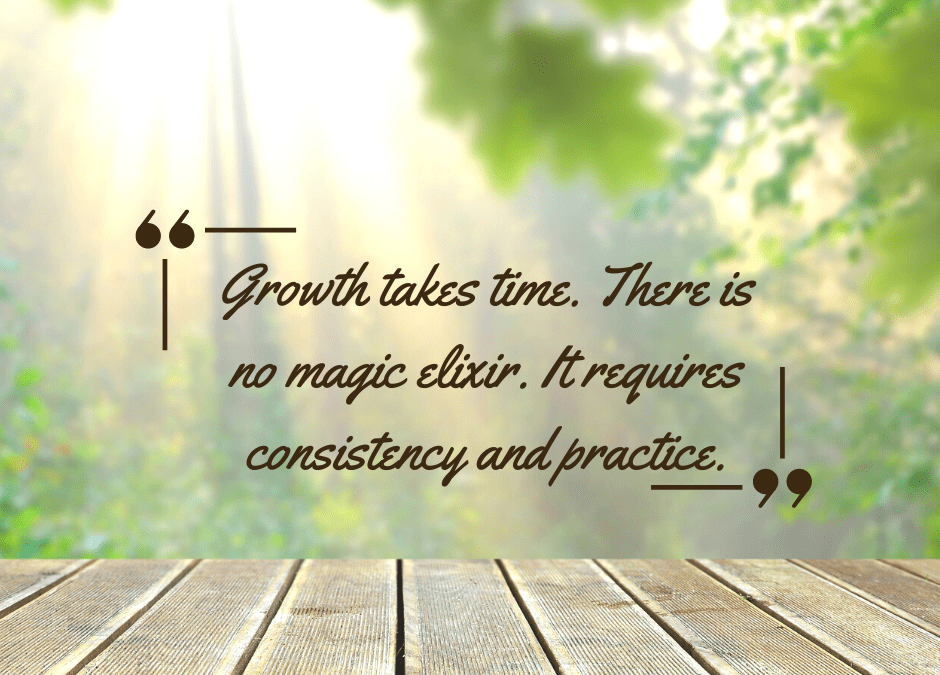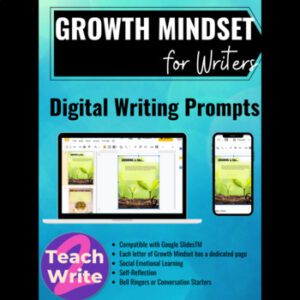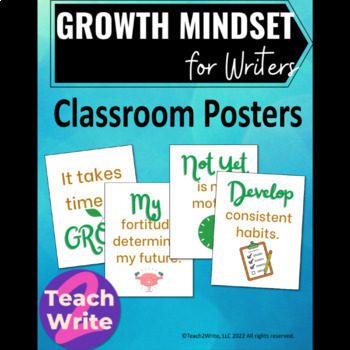In this blog post, I will be defining a growth mindset, provide empirical evidence that it is worth your time to teach, and eleven ways you can nurture a growth mindset in your classroom.
What is a Growth Mindset and Why Does it Matter?
Carol Dwek,a psychology professor at Stanford University, introduced the topic of growth mindset in her book, Mindset: The New Psychology of Success in 2006. Since then, teachers have embraced the ideas Dwek discussed to help their students grow, not only academically, but socially-emotionally as well.
According to Dwek, “A growth mindset is when students understand that their abilities can be developed,” (Dweck, 2014).
Helping students to navigate through their academic challenges while they are also going through major hormonal changes is a daunting task. However, this type of support is vital to help your students face the adversity and frustrations in school and in life.
Studies Conducted about Growth Mindset and the Link Between Teacher Support and Student Achievement in Reading:
The Organization for Economic Cooperation and Development (OECD) administered an assessment for growth mindset called the Program for International Student Assessment (PISA) in 2018 to 600,000 15 year old students from 78 countries. This assessment found that: “In the United States in particular, where about 70 percent of students demonstrated a growth mindset, it was associated with a 60-point higher score in reading.”
The report also identified teacher practices that contribute to students’ growth mindsets. “In the United States, students with a growth mindset outperformed those with a fixed mindset by 48 points in reading when they had low teacher support, but by 72 points when they had supportive teachers.”
To get more information directly from Carol Dwek, here is a TED talk by Carol Dwek conducted in 2014: The power of believing that you can improve
Here are eleven ways to nurture a growth mindset in your classroom:
#1. Rephrase negative self-defeating thoughts.
For example, change “I can’t do this” to “I can’t do this yet.” If a student seems overly frustrated and digs their heels in, smile. Tell them, “it’s okay, let’s take a breather.”
Then, if you have time, change the subject to something you know they like or tell them you’ll give them some time to destress, and then circle around to check on them later. Or ask another student for help. Kids often explain things better than we adults do.
To give students the language in order to rephrase their fixed mindset thinking, hang posters in your room about growth mindset. You can find some here that I created, just click here: Growth Mindset Posters for the Classroom.
Go over one each poster week. Also, you can use the poster of the week as a class motto. During a discussion about a character or real person’s resilience against adversity, ask students what growth mindset strategies were used.
#2. Show kids some strategies for opening their vagus nerve.
Anxiety often overtakes a student’s mind, and they need a way to calm their “flight, fright or freeze” response. Anxiety often fixes a student in a mindset that blocks them from trying or makes them feel overwhelmed.
Do some research about the vagus nerve and how to reset their parasympathetic nervous system. It may work for them. Here is one video I’ve used that helps: https://www.youtube.com/embed/L1HCG3BGK8I?start=328&end=456
This link only gives the exercise itself, but you can watch the whole video if you want to for background knowledge about the vagus nerve and its effect on anxiety. The exercise itself only takes about a minute.
#3. Take brain breaks.
These simple exercises that bring movement into your classroom. These can also help to rest the anxious thoughts. Here is a link to a great one I’ve found: https://www.youtube.com/embed/2ymSIxgwELg – this might be suited more for 6th grade.
Older students may want to do a different type of brain break: https://www.youtube.com/embed/DljEkH3ibj8
#4. Assign growth mindset writing prompts.
Get students thinking and discussing with growth mindset writing prompts. You can use them for bellwork or exit tickets. This is great for discussions and opening up a student’s mind to how they process their own fixed and growth mindsets. Click here for the Growth Mindset Writing Prompts.
These growth mindset writing prompts can be a touchstone for longer pieces of personal narratives in your writing workshop classroom.
#5. Practice giving and taking helpful feedback.
Use a list of sentence stems students can use as partners. You’ll need a list of how to give constructive feedback as well as how to respond to this feedback. Model this for students, too. Ask for a volunteer to act it out with you. Praise their process, effort, strategies and improvement.
#6. Show students how to braindump their thoughts and prioritize tasks.
Categorize tasks into: urgent tasks, working on tasks, and what I can do later tasks. Choose ONE urgent task and set a S.M.A.R.T. goal to achieve this task.
#7. Set S.M.A.R.T. goals.
A goal that is specific and narrow, measurable that progress can be collected, achievable in the timeframe set, relevant to long term goals, and time period with realistic end date for the specific goals. Click here for a free resource on SMART goals to use in your classroom.
#8. Evaluate your mindset as well as the process and work itself.
Use exit tickets as a way for students to evaluate their goals and the process of reaching those goals. Click here for these: Growth Mindset Exit Tickets.
#9. Give students the tools to track their progress.
Are you following your plan? Does the plan need to be tweaked? Do you need to employ another strategy? Use rubrics to help students track their progress for writing/reading tasks or skills.
#10. Effort is required to build skills.
Ask students about their experiences with learning new skills. Explain your own struggles with learning. Scaffold what you can to help students, but allow them to choose their own strategies and grapple with their difficulties. Support them through their efforts as they build resilience as well as skills.
For example, I share an anecdote with students how I’d always been an “A” student in English, until I got to college. I’d never learned how to write timed essays in high school. I had a whole week to turn in my essays, so I never had a timed writing essay before college.
However, in my freshman year, I was earning “Ds” and “Fs.” During those essay exams, I didn’t know what to write about, and I froze up. I needed a strategy to overcome this fixed mindset.
So, I started to plan my essays before I got to class. I would memorize my plans because we weren’t allowed to bring anything but a pencil to class. This taught me that with some effort, time, and the mindset of “not yet,” I could learn how to write a timed essay. I was successful enough to earn a B by the end of the semester. That was the hardest “B” I had ever worked for. This also taught me that my effort was more important than the grade.
#11. Celebrate one students’ success by rewarding all of the students in honor of the successful students’ accomplishment.
For example, you could say something like “because Bella worked so hard on her paper this week and completed it, in her honor, we are… Thank Bella, not me.” then do something special like a game, outside time or a special snack or privilege.
I did not come up with this idea myself, I got it from Brian Mendler on Instagram. It is a great idea to allow students to celebrate each others’ successes. Here is the link to that post: https://www.instagram.com/p/Cibg1vIgtiU/
Nurture a growth mindset in your classroom and watch your students succeed.
Works Cited:
“Growth Mindset.” Renaissance , Renaissance Learning, Inc., https://www.renaissance.com/edword/growth-mindset/2022/9/20.
Sparks, Sarah D. “’Growth Mindset’ Linked to Higher Test Scores, Student Well-Being in Global Study.” Education Week, Education Week, 20 Apr. 2021, https://www.edweek.org/leadership/growth-mindset-linked-to-higher-test-scores-student-well-being-in-global-study/2021/04.
Highly Engaging Resources for Teaching a Growth Mindset
If you would like some growth mindset resources for your classroom, check out these resources:



